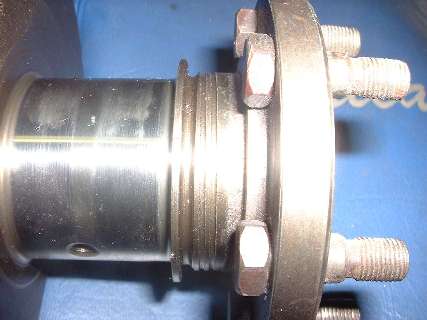The MGA With An Attitude
REAR Main Bearing OIL SEAL Dimensions - CS-109
MGA engines do not have a rubber seal at the rear end of the crankshaft. A mechanical scroll seal is incorporated here. At the very rear of the engine block the crankshaft runs very close clearance to the block and main bearing cap. There is a narrow helical groove in the crankshaft that works like an auger to pull stray oil forward into a drain cavity in the bearing cap when the engine is running.

At Engine No. BP15GB-6615 the minimum running clearance here was increased by 0.002-inch, apparently to prevent physical contact between the crankshaft and surrounding metal of the block and bearing cap. This was done by reducing the maximum diameter on the crankshaft by 0.002", and also reducing machining tolerance for the diameter of the crankshaft to avoid having too much clearance in worst case of tolerance build-up. The final running clearance is intended to be 0.003" to 0.006" (0.076mm to 0.152mm). Notice how this compares to a nominal 0.002" diametrical oil film clearance in the main bearing journals.
Refer to Confidential Service Memorandum MG/212 - Rear Main Bearing Oil Leaks. For early engines the diameter on the crankshaft was 2.1405"/2.1390". This was then reduced to 2.1385"/2.1380". To maintain total running clearance of 0.003"/0.006", the mating bore in the block and bearing cap must be in the range of 2.1415"/2.1440". Some early production engines may need to have 0.001" of material scraped from the bore of the housing to achieve the minimum specified clearance. Notice that this seal area inside diameter is a few thousandths of an inch smaller than the bore size for the main bearing cradles (nominally 2.146"). This is important to keep in mind when line boring an engine block If you bore the rear seal surface to the same size as the main bearing cradles, the rear seal will have too much running clearance and would likely leak profusely.
To avoid metal to metal contact between the crankshaft and the block and bearing cap, the main bearing shells should not be allowed to run in worn condition with excessive clearance. Occasionally replacing main bearing shells is good insurance against this happening.
If the main bearing shells become excessively worn allowing the crankshaft to come into contact with the block and bearing cap, the mating metal parts can be damaged which in turn can allow excessive oil leakage at the rear of the engine. The apparent fix for this is to install a new crankshaft. Also have the main bearing caps shaved slightly and re-installed, then line bore the main bearing journals to restore the original inside diameter. This is expensive for both parts and labor.
It is exceedingly difficult to rebuild the metal on the crankshaft and re-machine the scroll seal surface.
A makeshift way to save a slightly worn crankshaft could be to re-grind the OD at the scroll surface, and then shave and line bore the bearing caps to reduce the mating bore diameter accordingly. Beware that this makes non-standard parts, and a new replacement crankshaft would then not fit in the reworked block (without more machining of the block).
An alternate (and much cheaper) solution for a serious oil leak may be to install a specially fabricated rubber seal.
Click for a spread sheet detailing
Dimensions For The Mechanical Rear Seal and Main Bearing Cradles
|
